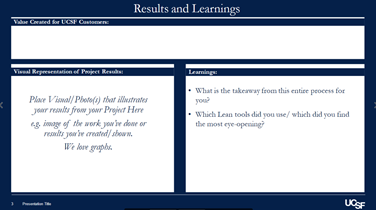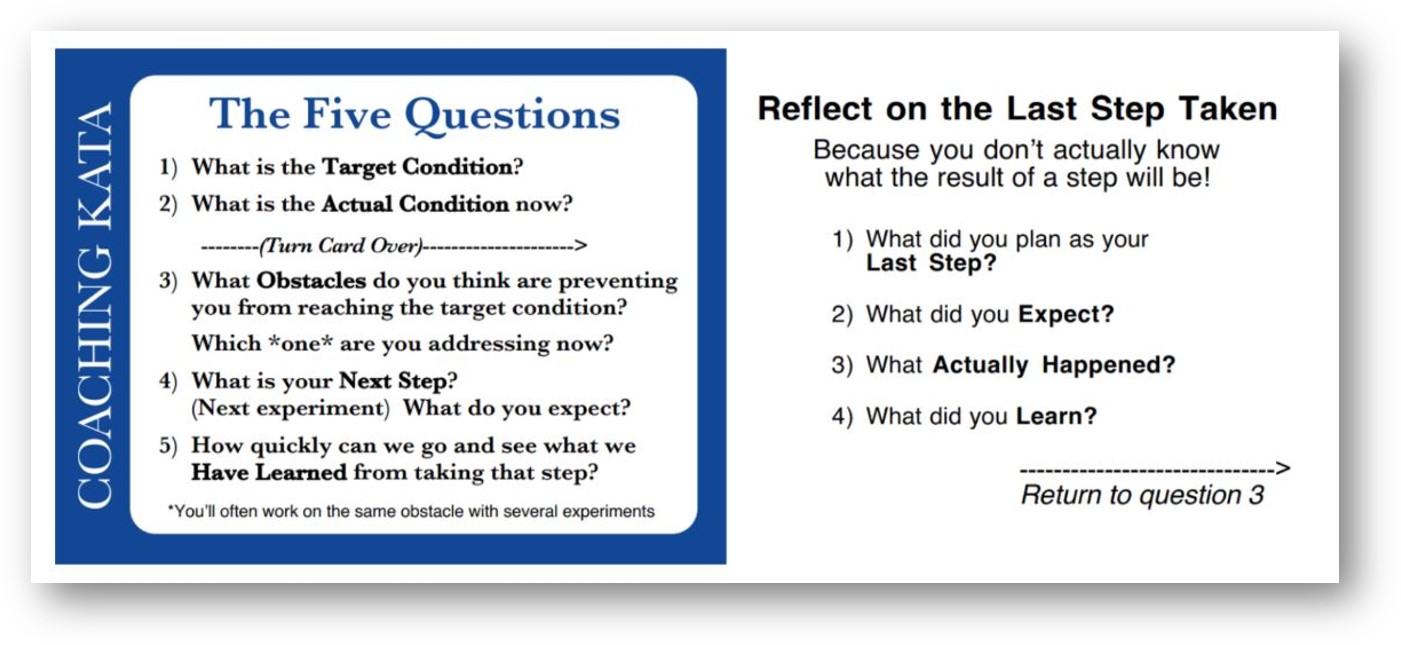Overview
Read on to find out what FAS Lean Practitioner Certification is, who is eligible to apply, and how to submit an application.
What is Lean Practitioner Certification?
FAS Lean Practitioner Certification celebrates and recognizes participants who have demonstrated a conceptual understanding of Lean and the thought process behind the A3 framework, including defining the problem, explaining the gaps between the current condition and target condition, and proposing countermeasures to address the root causes. Participants show the effective application of A3 Thinking to address a problem in their functional area by leading at least one cycle of change, implementing at least one countermeasure, and having measurable results to share from it. All UCSF employees are eligible to apply. Application cycles for certification run year-round, and at least two ceremonies are conducted annually to showcase candidates’ projects through A3 presentation and reflection.
Why is Becoming Certified Important?
Individual Level
- Enhance leadership, team engagement, and critical thinking skills
- Build practical skills to create value for any job, improving personal work performance
- Solve problems to create more capacity to do higher-level thinking, optimize the use of your talents to benefit you, your team, and your department
Organizational Level
- Inspire others to join you to actively improve the way your department processes run, raise awareness of important issues
- Contribute to organizational learning to help FAS achieve its goals in Continuous Improvement and Value Creation
- Be recognized in your department and in FAS as having working knowledge/experience with applying Lean problem-solving methodology
How Do I Get Certified?
Step 1: Training
UCSF employees are eligible for Lean Practitioner Certification by meeting any of the following training criteria:
- Completing Lean courses offered by the PMO:
- Former courses (until 2022): Lean Fundamentals, A3 Thinking for Supervisors and Managers.
- New courses (Beginning in 2023): Intro to Lean + A3 Thinking 101
- Leading a Value Improvement Project
- Leading change through a FAS Active Daily Engagement (ADE) huddle
- Learning Lean at UCSF, through an external agency, or studying independently and applying concepts to an improvement at UCSF
Step 2: Demonstrating the application of A3 Thinking and Lean tools
- Show your understanding of Lean by developing an A3 to tell the story of your improvement project. This should be work on a real project that benefits your organization while solidifying Lean practices. (Please see UCSF PMO A3 template image above)
- Once you have implemented at least one cycle of change and have measurable results, complete your A3 using either the Powerpoint or Word version of the UCSF Lean Practitioner Certification Application to document a refined version of your improvement project as well as related results and learning (see results and learning template image below)
- UCSF Lean Practitioner Certification Application (Powerpoint version)
- UCSF Lean Practitioner Certification Application (Word version)
- Email your application to [email protected] and cc: [email protected]. The application is peer-reviewed by the PMO Lean Instructors and coaches against the review criteria explained on the left and right margins of the A3 template.
Part 2: Results and Learning page (Included in Lean Practitioner Application Template)
Step 3: Presenting your A3
To celebrate and share your improvement work, you will have 5 minutes to present your A3 and the results and learning slide to your supervisor, teammates, and leadership. Following each presentation will be 3 minutes for questions and comments.
What is catchball? Catchball involves moving ideas and information from one person or team to another
How is it used? Presenters pitch their A3s to the audience, and the audience pitches questions back to help expand and deepen their thinking.
Coaching Kata is used as a guide for asking questions during Catchball
Lean Practitioner Certification Criteria
Your A3 Application must stand alone to tell a cohesive story.
"Left Side Thinking"
Title:
- The title has a clear topic, does not contain a solution, and connects to True North Pillar.
Background:
- Describe the context for why this is important right now, what the business case is, and who the story is about.
Current Condition:
- Offer evidence of current work conditions; specific things or patterns that are actually happening/observed at the Gemba.
- Includes process map or data describing the current condition.
- Does not contain possible ideas or root causes.
Problem Statement:
- Focus on work processes.
- Is not a solution written as a problem.
- Is one or two sentences summarizing a critical condition to address the current state based on understanding the type of gap you have (either caused or created).
- written in performance and measurable terms: Specific, Measurable, Achievable, Relevant, and Time-Bound (SMART).
Target Conditions (Goals):
- Describes what needs to be brought into existence
- written in performance and measurable terms: Specific, Measurable, Achievable, Relevant, Time-Bound (SMART)
Gap Analysis/ Root Cause Thinking:
- root causes were derived using cause-effect tools (include an image of 5-whys, fish bone analysis if used)
- if a 5-whys analysis is used, logic should make sense when reversed or worked from the bottom up.
"Right Side Thinking"
Experiments/Ideas to Test:
- Proposed countermeasures tie back to a root cause it intends to reduce or eliminate.
- Lists in-process metrics to be measured for each countermeasure and reviewed regularly as evidence of progress.
Action Plan:
- Details what needs to be in place in order to begin/run your experiments.
- What, by who, how much, and by when.
- Includes who will measure what, where, how and when they will be collected and reported.
Study:
- Describe conditions you will watch for in order to see whether experiments are working.
Reflect:
- Include metrics to explain what worked, what didn't, and what the next steps are.
Plan Next Steps:
- List how ongoing Plan-Do-Check-Adjust (PDCA) will happen (who, what, where, when, and how often).
- Indicate other things you still need to think about or do after completing some of the proposed experiments or to be done concurrently.
- Include a task for the author to update this A3 when new information becomes available.
Remember: A3 Thinking/ Problem Solving supports a continuous improvement culture at UCSF
We Show Respect for People by
- Engaging others and Catchball early and often.
- Finding ways to share your thinking and learning.
We Continuously Improve by
- Solving problems to make improvements as part of the regular work.
- Use PDCA to make incremental changes until the causes of the problem are eliminated, constraints are overcome, and barriers are no longer in your way.
What Comes After Certification?
Consider submitting your improvement project to an open call or attending an Improvement conference:
- Institute For Healthcare improvement (IHI Forum)
- IHI Forum Proposal Webinair April 2nd, 2024
- Abstracts due April 30th, 2024 (Posters Due in November)
- Lean Higher Education (Lean HE)
- Process Palooza! (Check out "The Great Innovate")
- Network for Change and Continuous Innovation (NCCI)
- CHEC through CSU



